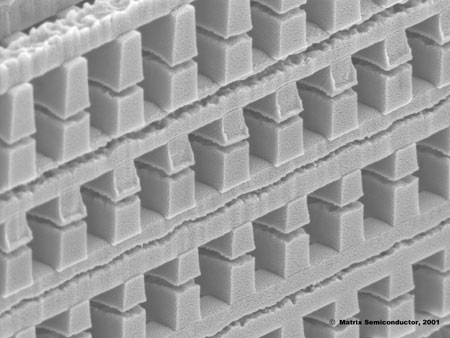|

|
New 3D silicon
technology is very intriguing, and it if it works half as well as they say it
will could offer up some substantial performance increases.
|
|
|
|
Home >
Reviews >
Press Release >
Matix |
|
|
Matrix's Three-Dimensional Semiconductor
Products
We don't generally post press releases here, but this new 3D silicon
technology is very intriguing, and it if it works half as well as they say it
will could offer up some substantial performance increases to us. I wouldn't
expect to see any memory based on 3D Silicon manufacturing till late in 2002
however.
"The 3-D Technology Breakthrough Existing integrated circuits are built using
active devices within a single layer of silicon. Additional layers above the
substrate are used for wiring and structural strength. Matrix has developed and
patented the technology to build 3-dimensional memory by stacking memory arrays
vertically. Matrix 3-D Memory's array structure results in an archival storage
device capable of storing data for more than 100 years. Matrix's memory is
manufactured in a standard CMOS fab, using existing semiconductor materials and
production equipment. 3-D Means Much Smaller Chips and Much Lower Cost By
stacking memory elements vertically, Matrix uses a much smaller die area for a
given density than traditional DRAM, SRAM, flash, and Mask ROM. By decreasing
the chip size and increasing the yield, Matrix 3-D Memory can be produced at a
fraction of the cost of existing technologies. Matrix 3-D Memory will scale at
least as fast as other semiconductor technologies, maintaining its significant
cost advantage with future process generations. By building semiconductor products
in three dimensions, Matrix's technology makes the best use of a semiconductor
wafer's area and achieves up to a tenfold cost reduction compared with existing
technologies.  By building "up" as well as "out," Matrix can dramatically
increase the number of bits per silicon wafer and design chips for high-volume
production at the absolute lowest cost. As importantly, Matrix can achieve these
benefits using the standard materials, equipment, and processes already present
and very well understood in the world's semiconductor manufacturing foundries.
While others have attempted to produce a working three-dimensional chip, Matrix
is the first to develop the methods to manufacture such products in high
volumes, at low costs, and using standard materials and
processes. By building "up" as well as "out," Matrix can dramatically
increase the number of bits per silicon wafer and design chips for high-volume
production at the absolute lowest cost. As importantly, Matrix can achieve these
benefits using the standard materials, equipment, and processes already present
and very well understood in the world's semiconductor manufacturing foundries.
While others have attempted to produce a working three-dimensional chip, Matrix
is the first to develop the methods to manufacture such products in high
volumes, at low costs, and using standard materials and
processes.
Matrix and its technical team have been
granted two U.S. patents covering the inventions around 3-D semiconductor design
and production, and have filed over 60 additional
applications.
3-D Semiconductors In 2002
The first
product based on Matrix's technology will be Matrix 3-D Memory, the first semiconductor
memory developed for use as a "consumable," much like traditional camera film
or audio tape. The initial markets for this first product will
include archival storage for portable electronic devices such as digital cameras,
digital audio players, portable games, PDAs, cell phones, and others. The technology
also demonstrates great promise as a medium for pre-recorded content, such
as music, electronic books, games, digital maps, and reference guides. Matrix 3-D
Memory will be archival memory designed to store information securely for many
decades. Memory cards based on Matrix 3-D Memory will be write-once,
available in standard flash card form factors, and interchangeable with standard flash cards.
Based on these characteristics and its low cost,
Matrix will come to market under some of the world's most recognized brands in
2002. In addition to expanding Matrix 3-D Memory's applications, Matrix
Semiconductor will continue to develop other semiconductor products based on 3-D
technology. "Demonstrating that
3-D semiconductors are a reality today provides exciting promise to an industry
ever innovating to meet market challenges," said Dr. Tom Lee, Stanford
University Professor, Founder, and Director of Advanced Product Development at
Matrix Semiconductor. "Matrix 3-D Memory will be a first, very important step in
commercializing 3-D semiconductor technology. Breakthroughs of this magnitude do
not happen often, and we are extremely excited about the markets for this
product and the future applications of this
technology."
Founded in 1998, Matrix
Semiconductor has developed the means to create three-dimensional semiconductors
using standard manufacturing techniques and materials. By optimizing use of a
semiconductor wafer's area -- building "up" rather than "out" -- Matrix's 3-D
technology produces ultra-dense chips for high-volume markets at dramatically
lower costs than comparable technologies. Matrix's first product based on the
technology, Matrix 3-D Memory (3DM) will combine the compact size, ruggedness,
and low system cost of solid-state electronics with the cost-per-megabyte of
disk technologies."
Contents of Article: Matix
|
|
|
|
|
|
|
|

